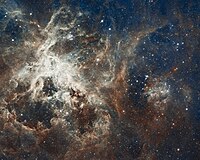Orion Spacecraft accomplishes first spaceflight test
Monday, December 8, 2014

Image: NASA/Bill Ingalls.
NASA has finally accomplished its first spaceflight with the new Orion spacecraft, uncrewed, on Friday morning. The spacecraft has now traveled farther from the Earth than any other spacecraft designed to carry a crew has traveled in over four decades.
The Orion crew module was launched off from Space Launch Complex 37 at the Cape Canaveral Air Force Station in Florida mounted on top of a United Launch Alliance Delta IV Heavy rocket. Four and a half hours later, the space module landed in the Pacific Ocean.
During the mission, the spacecraft reached an altitude of 3,600 miles (5800 kilometers) and experienced periods of intense radiation when traveling twice through the Van Allen belt. Upon re-entry in the Earth's atmosphere, Orion achieved speeds of 20,000 miles per hour (32,000 kilometers per hour) and temperatures reached 4,000 degrees Fahrenheit (2200 degrees Celsius).
NASA has reported the entire spacecraft remained in one piece, with all the onboard computers still working despite the high radiation in the Van Allen belt. All the parachutes deployed without incident.
NASA said this is the farthest spacecraft have flown since the Apollo 17 mission 42 years ago, opening up new human explorations of space and getting closer to the goal of putting people on Mars.
Had astronauts been on board Orion, they would have experienced 8.2 times the force of gravity on Earth, NASA said.
Astronaut Rex Walheim, of the last Space Shuttle mission, talked about future crewed Mars missions and becoming "a multi-planetary species".
The Orion program manager hopes NASA will look at information from this spaceflight and apply it to the next Orion spacecraft, to be launched by the Space Launch System rocket.
Sources
- Rachel Kraft, Brandi K. Dean, Michael Curie. "NASA’s New Orion Spacecraft Completes First Spaceflight Test" — NASA, December 5, 2014
- Marcia Dunn (AP). "NASA: 'There's Your New Spacecraft, America!"" — ABC News, December 5, 2014


